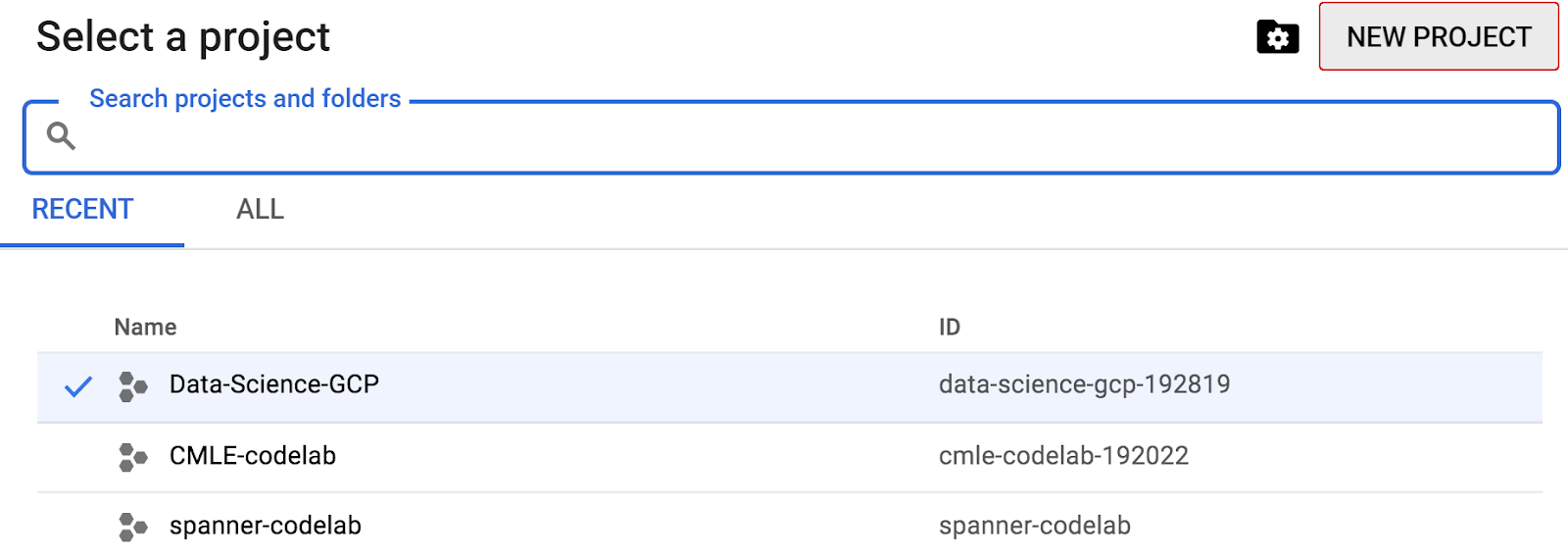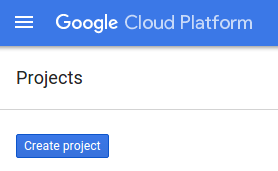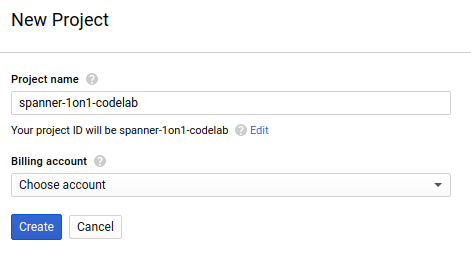1. 總覽
Google Cloud Spanner 是全代管且遍及全球的關聯資料庫服務,提供 ACID 交易和 SQL 語意,但不會犧牲效能及高可用性。
在本研究室中,您將瞭解如何設定 Cloud Spanner 執行個體。並逐步建立可用於遊戲排行榜的資料庫和結構定義。第一步是建立用於儲存玩家資訊的「玩家」表格,以及用來儲存玩家得分的「得分」表格。
接下來要將範例資料填入資料表。接著,您將於課程結束之前執行一些前十大範例查詢,最後刪除執行個體來釋出資源。
課程內容
- 如何設定 Cloud Spanner 執行個體。
- 如何建立資料庫和資料表。
- 如何使用修訂時間戳記欄。
- 如何將含有時間戳記的資料載入 Cloud Spanner 資料庫資料表。
- 如何查詢 Cloud Spanner 資料庫。
- 如何刪除 Cloud Spanner 執行個體。
軟硬體需求
您會如何使用這個教學課程?
您對 Google Cloud Platform 的使用感想為何?
2. 設定和需求
自修環境設定
如果您還沒有 Google 帳戶 (Gmail 或 Google Apps),請先建立帳戶。登入 Google Cloud Platform 控制台 ( console.cloud.google.com),並建立新專案。
如果您已有專案,請按一下控制台左上方的專案選取下拉式選單:

並點選 [新增專案]按鈕,用於建立新專案:

如果您還沒有專案,系統會顯示如下的對話方塊,讓您建立第一個專案:

後續的專案建立對話方塊可讓您輸入新專案的詳細資料:

請記住,專案 ID 在所有的 Google Cloud 專案中是不重複的名稱 (已經有人使用上述名稱,目前無法為您解決問題!)。稍後在本程式碼研究室中會稱為 PROJECT_ID。
接下來,如果您尚未在 Developers Console 中啟用計費功能,必須完成此步驟,才能使用 Google Cloud 資源並啟用 Cloud Spanner API。

執行本程式碼研究室所需的費用不應超過數美元,但如果您決定使用更多資源,或讓這些資源繼續運作,費用會增加 (請參閱本文件結尾的「清理」一節)。如需 Google Cloud Spanner 的定價資訊,請參閱這裡。
Google Cloud Platform 的新使用者符合 $300 美元的免費試用資格,應該可以免費使用本程式碼研究室。
Google Cloud Shell 設定
雖然 Google Cloud 和 Spanner 可以在筆記型電腦上遠端運作,但在本程式碼研究室中,我們會使用 Google Cloud Shell,這是一種在 Cloud 中執行的指令列環境。
這種以 Debian 為基礎的虛擬機器,搭載各種您需要的開發工具。提供永久的 5 GB 主目錄,而且在 Google Cloud 中運作,大幅提高網路效能和驗證能力。換言之,本程式碼研究室只需要在 Chromebook 上運作即可。
- 如要透過 Cloud 控制台啟用 Cloud Shell,只要點選「啟用 Cloud Shell」 圖示
即可 (整個佈建作業只需幾分鐘的時間,操作完畢即可)。
連線至 Cloud Shell 後,您應會發現自己通過驗證,且專案已設為 PROJECT_ID。
gcloud auth list
指令輸出
Credentialed accounts: - <myaccount>@<mydomain>.com (active)
gcloud config list project
指令輸出
[core] project = <PROJECT_ID>
如因故未設定專案,請直接發出以下指令:
gcloud config set project <PROJECT_ID>
正在尋找 PROJECT_ID 嗎?查看您在設定步驟中使用的 ID,或在 Cloud 控制台資訊主頁查詢:
根據預設,Cloud Shell 也會設定一些環境變數,方便您之後執行指令。
echo $GOOGLE_CLOUD_PROJECT
指令輸出
<PROJECT_ID>
- 最後,進行預設可用區和專案設定。
gcloud config set compute/zone us-central1-f
您可以選擇各種不同的可用區。詳情請參閱「區域與可用區。
摘要
在這個步驟中,您會設定環境。
下一步
接下來,您將設定 Cloud Spanner 執行個體。
3. 設定 Cloud Spanner 執行個體
在這個步驟中,我們會為本程式碼研究室設定 Cloud Spanner 執行個體。請在左上方的漢堡選單 
 搜尋 Spanner 項目,或按下「/」搜尋 Spanner然後輸入「Spanner」
搜尋 Spanner 項目,或按下「/」搜尋 Spanner然後輸入「Spanner」

接下來,按一下  ,然後為執行個體輸入執行個體名稱 cloudspanner-leaderboard、選擇設定 (選取區域執行個體),並設定節點數量,藉此填寫表單。這個程式碼研究室只需要 1 個節點。如需實際工作環境執行個體,以及符合 Cloud Spanner 服務水準協議的資格,您必須在 Cloud Spanner 執行個體中執行 3 個以上的節點。
,然後為執行個體輸入執行個體名稱 cloudspanner-leaderboard、選擇設定 (選取區域執行個體),並設定節點數量,藉此填寫表單。這個程式碼研究室只需要 1 個節點。如需實際工作環境執行個體,以及符合 Cloud Spanner 服務水準協議的資格,您必須在 Cloud Spanner 執行個體中執行 3 個以上的節點。
最後,點選 [建立]而且您能在幾秒內使用 Cloud Spanner 執行個體

在下一個步驟中,我們會使用 Java 用戶端程式庫,在新的執行個體中建立資料庫和結構定義。
4. 建立資料庫和結構定義
在這個步驟中,我們會建立範例資料庫和結構定義。
讓我們使用 Java 用戶端程式庫建立兩個資料表:玩家資訊表以及儲存玩家分數的得分錶格。因此,我們會逐步講解在 Cloud Shell 中建立 Java 控制台應用程式的步驟。
請先在 Cloud Shell 輸入下列指令,從 GitHub 複製本程式碼研究室的程式碼範例:
git clone https://github.com/GoogleCloudPlatform/java-docs-samples.git
然後,將目錄變更為「applications」,以便建立應用程式。
cd java-docs-samples/spanner/leaderboard
本程式碼研究室所需的所有程式碼都位於現有的 java-docs-samples/spanner/leaderboard/complete 目錄中,做為名為 Leaderboard 的可執行 C# 應用程式,可讓您在參與本程式碼研究室的過程中做為參考。我們將分階段建立新的目錄,並分階段建立排行榜應用程式副本。
建立名為「codelab」的新目錄,並使用下列指令將目錄變更為該目錄:
mkdir codelab && cd $_
建立名為「Leaderboard」(排行榜) 的新基本 Java 應用程式使用下列 Maven (mvn) 指令:
mvn -B archetype:generate -DarchetypeGroupId=org.apache.maven.archetypes -DgroupId=com.google.codelabs -DartifactId=leaderboard -DarchetypeVersion=1.4
這個指令會建立一個簡易的主控台應用程式,包含兩個檔案主要檔案:Maven 應用程式設定檔 pom.xml,以及 Java 應用程式檔案 App.java。
接著,將目錄變更為剛才建立的排行榜目錄,並列出其內容:
cd leaderboard && ls
畫面上應該會列出 pom.xml 檔案和 src 目錄:
pom.xml src
現在讓我們透過編輯 App.java 來使用 Java Spanner 用戶端程式庫,建立含有兩個資料表的排行榜,以更新這個控制台應用程式。玩家和分數:您可以直接在 Cloud Shell 編輯器中執行這項操作:
請點選下方醒目顯示的圖示,開啟 Cloud Shell 編輯器:

開啟排行榜資料夾下的 pom.xml。開啟位於 java-docs-samples\ spanner\leaderboard\codelab\leaderboard 資料夾中的 pom.xml 檔案。這個檔案會設定 Maven 建構系統,以將應用程式建構為 jar 檔案,包括所有依附元件。
在現有的 </properties> 下方新增下列 1 個新的依附元件管理部分元素:
<dependencyManagement>
<dependencies>
<dependency>
<groupId>com.google.cloud</groupId>
<artifactId>google-cloud-bom</artifactId>
<version>0.83.0-alpha</version>
<type>pom</type>
<scope>import</scope>
</dependency>
</dependencies>
</dependencyManagement>
並在現有的 <dependencies> 中新增 1 個新的依附元件一節,將 Cloud Spanner Java 用戶端程式庫新增至應用程式。
<dependency>
<!-- Version auto-managed by BOM -->
<groupId>com.google.cloud</groupId>
<artifactId>google-cloud-spanner</artifactId>
</dependency>
然後替換 pom.xml 檔案現有的 <build>內含以下 <build> 的部分區段:
<build>
<plugins>
<plugin>
<artifactId>maven-assembly-plugin</artifactId>
<version>2.5.5</version>
<configuration>
<finalName>leaderboard</finalName>
<descriptorRefs>
<descriptorRef>jar-with-dependencies</descriptorRef>
</descriptorRefs>
<archive>
<manifest>
<mainClass>com.google.codelabs.App</mainClass>
</manifest>
</archive>
<appendAssemblyId>false</appendAssemblyId>
<attach>false</attach>
</configuration>
<executions>
<execution>
<id>make-assembly</id>
<phase>package</phase>
<goals>
<goal>single</goal>
</goals>
</execution>
</executions>
</plugin>
<plugin>
<groupId>org.apache.maven.plugins</groupId>
<artifactId>maven-failsafe-plugin</artifactId>
<version>3.0.0-M3</version>
</plugin>
<plugin>
<groupId>org.apache.maven.plugins</groupId>
<artifactId>maven-surefire-plugin</artifactId>
<version>3.0.0-M3</version>
<configuration>
<useSystemClassLoader>false</useSystemClassLoader>
</configuration>
</plugin>
</plugins>
</build>
選取「儲存」,儲存您對 pom.xml 檔案所做的變更查看 Cloud Shell 編輯器的或是按下「Ctrl」鍵和「S」同時用鍵盤和鍵盤按鍵。
接著,透過位於 src/main/java/com/google/codelabs/ 資料夾的 Cloud Shell 編輯器開啟 App.java 檔案。將下列 Java 程式碼貼到 App.java 檔案,以建立 leaderboard 資料庫和 Players 和 Scores 資料表所需的程式碼,取代檔案現有的程式碼:
package com.google.codelabs;
import com.google.api.gax.longrunning.OperationFuture;
import com.google.cloud.spanner.Database;
import com.google.cloud.spanner.DatabaseAdminClient;
import com.google.cloud.spanner.DatabaseClient;
import com.google.cloud.spanner.DatabaseId;
import com.google.cloud.spanner.Spanner;
import com.google.cloud.spanner.SpannerException;
import com.google.cloud.spanner.SpannerExceptionFactory;
import com.google.cloud.spanner.SpannerOptions;
import com.google.spanner.admin.database.v1.CreateDatabaseMetadata;
import java.util.Arrays;
import java.util.concurrent.ExecutionException;
/**
* Example code for using the Cloud Spanner API with the Google Cloud Java client library
* to create a simple leaderboard.
*
* This example demonstrates:
*
* <p>
*
* <ul>
* <li>Creating a Cloud Spanner database.
* </ul>
*/
public class App {
static void create(DatabaseAdminClient dbAdminClient, DatabaseId db) {
OperationFuture<Database, CreateDatabaseMetadata> op =
dbAdminClient.createDatabase(
db.getInstanceId().getInstance(),
db.getDatabase(),
Arrays.asList(
"CREATE TABLE Players(\n"
+ " PlayerId INT64 NOT NULL,\n"
+ " PlayerName STRING(2048) NOT NULL\n"
+ ") PRIMARY KEY(PlayerId)",
"CREATE TABLE Scores(\n"
+ " PlayerId INT64 NOT NULL,\n"
+ " Score INT64 NOT NULL,\n"
+ " Timestamp TIMESTAMP NOT NULL\n"
+ " OPTIONS(allow_commit_timestamp=true)\n"
+ ") PRIMARY KEY(PlayerId, Timestamp),\n"
+ "INTERLEAVE IN PARENT Players ON DELETE NO ACTION"));
try {
// Initiate the request which returns an OperationFuture.
Database dbOperation = op.get();
System.out.println("Created database [" + dbOperation.getId() + "]");
} catch (ExecutionException e) {
// If the operation failed during execution, expose the cause.
throw (SpannerException) e.getCause();
} catch (InterruptedException e) {
// Throw when a thread is waiting, sleeping, or otherwise occupied,
// and the thread is interrupted, either before or during the activity.
throw SpannerExceptionFactory.propagateInterrupt(e);
}
}
static void printUsageAndExit() {
System.out.println("Leaderboard 1.0.0");
System.out.println("Usage:");
System.out.println(" java -jar leaderboard.jar "
+ "<command> <instance_id> <database_id> [command_option]");
System.out.println("");
System.out.println("Examples:");
System.out.println(" java -jar leaderboard.jar create my-instance example-db");
System.out.println(" - Create a sample Cloud Spanner database along with "
+ "sample tables in your project.\n");
System.exit(1);
}
public static void main(String[] args) throws Exception {
if (!(args.length == 3 || args.length == 4)) {
printUsageAndExit();
}
SpannerOptions options = SpannerOptions.newBuilder().build();
Spanner spanner = options.getService();
try {
String command = args[0];
DatabaseId db = DatabaseId.of(options.getProjectId(), args[1], args[2]);
DatabaseClient dbClient = spanner.getDatabaseClient(db);
DatabaseAdminClient dbAdminClient = spanner.getDatabaseAdminClient();
switch (command) {
case "create":
create(dbAdminClient, db);
break;
default:
printUsageAndExit();
}
} finally {
spanner.close();
}
System.out.println("Closed client");
}
}
選取「儲存」,儲存您對 App.java 檔案所做的變更查看 Cloud Shell 編輯器的或前往 Google 試算表選單
您可以在 java-docs-samples/spanner/leaderboard/step4/src 目錄中使用 App.java 檔案,查看啟用 create 指令的程式碼後,App.java 檔案應如何呈現。
如要建構應用程式,請從 pom.xml 所在的目錄執行 mvn 套件:
mvn package
成功建構 Java jar 檔案後,請輸入下列指令,在 Cloud Shell 中執行產生的應用程式:
java -jar target/leaderboard.jar
您會看到如下所示的輸出:
Leaderboard 1.0.0
Usage:
java -jar leaderboard.jar <command> <instance_id> <database_id> [command_option]
Examples:
java -jar leaderboard.jar create my-instance example-db
- Create a sample Cloud Spanner database along with sample tables in your project.
從此回應中,我們可以看到這是 Leaderboard 應用程式,目前有一個可能的指令:create。我們可以看到 create 指令的預期引數是執行個體 ID 和資料庫 ID。
接著執行下列指令。
java -jar target/leaderboard.jar create cloudspanner-leaderboard leaderboard
幾秒後,您應該會看到類似下方的回應:
Created database [projects/your-project/instances/cloudspanner-leaderboard/databases/leaderboard]
在 Cloud 控制台的 Cloud Spanner 部分,您應該會在左側選單中看到新的資料庫和資料表。

在下一個步驟中,我們會更新應用程式,將一些資料載入新的資料庫。
5. 載入資料
我們現在有一個名為 leaderboard 的資料庫,內含兩份資料表;Players和Scores。現在,我們要使用 Java 用戶端程式庫,在 Players 資料表中填入玩家,並在 Scores 資料表中填入每位玩家的隨機分數。
如果 Cloud Shell 編輯器尚未開啟,請點選下方醒目標示的圖示開啟 Cloud Shell 編輯器:

接著,在 Cloud Shell 編輯器中編輯 App.java 檔案,新增 insert 指令,該指令可用於在 Players 資料表中插入 100 位玩家,也可以用該指令在 Players 資料表中為每位玩家插入 4 個隨機分數。Scores
首先,更新應用程式檔案頂端的 imports 部分,取代目前的內容,完成後看起來應如下所示:
package com.google.codelabs;
import static com.google.cloud.spanner.TransactionRunner.TransactionCallable;
import com.google.api.gax.longrunning.OperationFuture;
import com.google.cloud.spanner.Database;
import com.google.cloud.spanner.DatabaseAdminClient;
import com.google.cloud.spanner.DatabaseClient;
import com.google.cloud.spanner.DatabaseId;
import com.google.cloud.spanner.Mutation;
import com.google.cloud.spanner.ResultSet;
import com.google.cloud.spanner.Spanner;
import com.google.cloud.spanner.SpannerException;
import com.google.cloud.spanner.SpannerExceptionFactory;
import com.google.cloud.spanner.SpannerOptions;
import com.google.cloud.spanner.Statement;
import com.google.cloud.spanner.TransactionContext;
import com.google.spanner.admin.database.v1.CreateDatabaseMetadata;
import java.time.Instant;
import java.time.LocalDate;
import java.time.LocalDateTime;
import java.time.LocalTime;
import java.time.ZoneOffset;
import java.util.ArrayList;
import java.util.Arrays;
import java.util.List;
import java.util.Random;
import java.util.concurrent.ExecutionException;
import java.util.concurrent.ThreadLocalRandom;
接下來,在現有 create() 方法下方和現有 printUsageAndExit() 方法的上方,新增下列 insert、insertPlayers 和 insertScores 方法:
static void insert(DatabaseClient dbClient, String insertType) {
try {
insertType = insertType.toLowerCase();
} catch (Exception e) {
// Invalid input received, set insertType to empty string.
insertType = "";
}
if (insertType.equals("players")) {
// Insert players.
insertPlayers(dbClient);
} else if (insertType.equals("scores")) {
// Insert scores.
insertScores(dbClient);
} else {
// Invalid input.
System.out.println("Invalid value for 'type of insert'. "
+ "Specify a valid value: 'players' or 'scores'.");
System.exit(1);
}
}
static void insertPlayers(DatabaseClient dbClient) {
dbClient
.readWriteTransaction()
.run(
new TransactionCallable<Void>() {
@Override
public Void run(TransactionContext transaction) throws Exception {
// Get the number of players.
String sql = "SELECT Count(PlayerId) as PlayerCount FROM Players";
ResultSet resultSet = transaction.executeQuery(Statement.of(sql));
long numberOfPlayers = 0;
if (resultSet.next()) {
numberOfPlayers = resultSet.getLong("PlayerCount");
}
// Insert 100 player records into the Players table.
List<Statement> stmts = new ArrayList<Statement>();
long randomId;
for (int x = 1; x <= 100; x++) {
numberOfPlayers++;
randomId = (long) Math.floor(Math.random() * 9_000_000_000L) + 1_000_000_000L;
Statement statement =
Statement
.newBuilder(
"INSERT INTO Players (PlayerId, PlayerName) "
+ "VALUES (@PlayerId, @PlayerName) ")
.bind("PlayerId")
.to(randomId)
.bind("PlayerName")
.to("Player " + numberOfPlayers)
.build();
stmts.add(statement);
}
transaction.batchUpdate(stmts);
return null;
}
});
System.out.println("Done inserting player records...");
}
static void insertScores(DatabaseClient dbClient) {
boolean playerRecordsFound = false;
ResultSet resultSet =
dbClient
.singleUse()
.executeQuery(Statement.of("SELECT * FROM Players"));
while (resultSet.next()) {
playerRecordsFound = true;
final long playerId = resultSet.getLong("PlayerId");
dbClient
.readWriteTransaction()
.run(
new TransactionCallable<Void>() {
@Override
public Void run(TransactionContext transaction) throws Exception {
// Initialize objects for random Score and random Timestamp.
LocalDate endDate = LocalDate.now();
long end = endDate.toEpochDay();
int startYear = endDate.getYear() - 2;
int startMonth = endDate.getMonthValue();
int startDay = endDate.getDayOfMonth();
LocalDate startDate = LocalDate.of(startYear, startMonth, startDay);
long start = startDate.toEpochDay();
Random r = new Random();
List<Statement> stmts = new ArrayList<Statement>();
// Insert 4 score records into the Scores table
// for each player in the Players table.
for (int x = 1; x <= 4; x++) {
// Generate random score between 1,000,000 and 1,000
long randomScore = r.nextInt(1000000 - 1000) + 1000;
// Get random day within the past two years.
long randomDay = ThreadLocalRandom.current().nextLong(start, end);
LocalDate randomDayDate = LocalDate.ofEpochDay(randomDay);
LocalTime randomTime = LocalTime.of(
r.nextInt(23), r.nextInt(59), r.nextInt(59), r.nextInt(9999));
LocalDateTime randomDate = LocalDateTime.of(randomDayDate, randomTime);
Instant randomInstant = randomDate.toInstant(ZoneOffset.UTC);
Statement statement =
Statement
.newBuilder(
"INSERT INTO Scores (PlayerId, Score, Timestamp) "
+ "VALUES (@PlayerId, @Score, @Timestamp) ")
.bind("PlayerId")
.to(playerId)
.bind("Score")
.to(randomScore)
.bind("Timestamp")
.to(randomInstant.toString())
.build();
stmts.add(statement);
}
transaction.batchUpdate(stmts);
return null;
}
});
}
if (!playerRecordsFound) {
System.out.println("Parameter 'scores' is invalid since "
+ "no player records currently exist. First insert players "
+ "then insert scores.");
System.exit(1);
} else {
System.out.println("Done inserting score records...");
}
}
接著,為了讓 insert 指令正常運作,請將下列程式碼新增至應用程式的「main」switch (command) 陳述式中的方法:
case "insert":
String insertType;
try {
insertType = args[3];
} catch (ArrayIndexOutOfBoundsException exception) {
insertType = "";
}
insert(dbClient, insertType);
break;
完成之後,switch (command) 陳述式應如下所示:
switch (command) {
case "create":
create(dbAdminClient, db);
break;
case "insert":
String insertType;
try {
insertType = args[3];
} catch (ArrayIndexOutOfBoundsException exception) {
insertType = "";
}
insert(dbClient, insertType);
break;
default:
printUsageAndExit();
}
最後一步是新增「插入」那就是替「插入」新增至 printUsageAndExit() 方法。在 printUsageAndExit() 方法中新增以下這行程式碼,加入用於 insert 指令的說明文字:
System.out.println(" java -jar leaderboard.jar insert my-instance example-db players");
System.out.println(" - Insert 100 sample Player records into the database.\n");
System.out.println(" java -jar leaderboard.jar insert my-instance example-db scores");
System.out.println(" - Insert sample score data into Scores sample Cloud Spanner "
+ "database table.\n");
選取「儲存」,儲存您對 App.java 檔案所做的變更查看 Cloud Shell 編輯器的或前往 Google 試算表選單
您可以在 java-docs-samples/spanner/leaderboard/step5/src 目錄中使用 App.java 檔案,查看啟用 insert 指令的程式碼後,App.java 檔案應如何呈現。
現在,請重新建構並執行應用程式,確認新的 insert 指令已納入應用程式的可能指令清單中。
如要建構應用程式,請從 pom.xml 所在的目錄執行 mvn package:
mvn package
Java jar 檔案成功建構後,請執行下列指令:
java -jar target/leaderboard.jar
應用程式的預設輸出內容應會顯示 insert 指令:
Leaderboard 1.0.0
Usage:
java -jar leaderboard.jar <command> <instance_id> <database_id> [command_option]
Examples:
java -jar leaderboard.jar create my-instance example-db
- Create a sample Cloud Spanner database along with sample tables in your project.
java -jar leaderboard.jar insert my-instance example-db players
- Insert 100 sample Player records into the database.
java -jar leaderboard.jar insert my-instance example-db scores
- Insert sample score data into Scores sample Cloud Spanner database table.
您可以在回應中看到,除了執行個體 ID 和資料庫 ID 之外,還有另一個可以含有「players」值的引數或「分數」
現在,使用我們呼叫 create 指令時採用的相同引數值執行 insert 指令,新增「players」做為額外的「插入類型」引數。
java -jar target/leaderboard.jar insert cloudspanner-leaderboard leaderboard players
幾秒後,您應該會看到類似下方的回應:
Done inserting player records...
現在,我們要使用 Java 用戶端程式庫,在 Scores 資料表中填入四個隨機分數,以及 Players 資料表中每位玩家的時間戳記。
Scores 資料表的「Timestamp」欄定義為「修訂時間戳記」如下所示,該陳述式為在我們之前執行 create 指令時執行的下列 SQL 陳述式:
CREATE TABLE Scores(
PlayerId INT64 NOT NULL,
Score INT64 NOT NULL,
Timestamp TIMESTAMP NOT NULL OPTIONS(allow_commit_timestamp=true)
) PRIMARY KEY(PlayerId, Timestamp),
INTERLEAVE IN PARENT Players ON DELETE NO ACTION
請注意 OPTIONS(allow_commit_timestamp=true) 屬性。這會讓 Timestamp 成為「修訂時間戳記」資料欄,並在特定表格列上自動填入 INSERT 和 UPDATE 作業的確切交易時間戳記。
您也可以將自己的時間戳記值插入「修訂時間戳記」欄中,只要您插入時間戳記值在過去的時間戳記,我們就會對此程式碼研究室進行操作。
現在,使用我們呼叫 create 指令新增「scores」時使用的相同引數值執行 insert 指令做為額外的「插入類型」引數。
java -jar target/leaderboard.jar insert cloudspanner-leaderboard leaderboard scores
幾秒後,您應該會看到類似下方的回應:
Done inserting score records...
以「插入類型」執行 insert指定為 scores 會呼叫 insertScores 方法,該方法會使用下列程式碼片段,插入隨機產生的時間戳記,且時間戳記是在過去的日期:
LocalDate endDate = LocalDate.now();
long end = endDate.toEpochDay();
int startYear = endDate.getYear() - 2;
int startMonth = endDate.getMonthValue();
int startDay = endDate.getDayOfMonth();
LocalDate startDate = LocalDate.of(startYear, startMonth, startDay);
long start = startDate.toEpochDay();
...
long randomDay = ThreadLocalRandom.current().nextLong(start, end);
LocalDate randomDayDate = LocalDate.ofEpochDay(randomDay);
LocalTime randomTime = LocalTime.of(
r.nextInt(23), r.nextInt(59), r.nextInt(59), r.nextInt(9999));
LocalDateTime randomDate = LocalDateTime.of(randomDayDate, randomTime);
Instant randomInstant = randomDate.toInstant(ZoneOffset.UTC);
...
.bind("Timestamp")
.to(randomInstant.toString())
在 Timestamp 欄中自動填入「Insert」的確切時間交易發生,您可以改為插入 Java 常數 Value.COMMIT_TIMESTAMP,如以下程式碼片段所示:
.bind("Timestamp")
.to(Value.COMMIT_TIMESTAMP)
資料載入已完成,現在讓我們驗證剛才寫入新資料表的值。請先選取 leaderboard 資料庫,然後選取 Players 資料表。按一下「Data」分頁標籤。您應該會在表格的 PlayerId 和 PlayerName 欄中看到資料。

接著,請按一下 Scores 資料表並選取「Data」分頁標籤,確認「分數」表格也有資料。您應該會在表格的 PlayerId、Timestamp 和 Score 欄中看到資料。

非常好!讓我們更新應用程式,以便執行一些查詢,以便建立遊戲排行榜。
6. 執行排行榜查詢
資料庫設定完成,並將資訊載入表格後,我們就來使用這些資料建立排行榜吧。為此,請回答下列四個問題:
- 哪些玩家是「前十名」而非時間
- 哪些玩家是「前十名」該怎麼辦?
- 哪些玩家是「前十名」每月?
- 哪些玩家是「前十名」一週?
請更新應用程式,執行 SQL 查詢來回答這些問題。
我們將新增 query 指令,藉此執行查詢,找出會產生排行榜所需資訊的問題。
在 Cloud Shell 編輯器中編輯 App.java 檔案,藉此更新應用程式來新增 query 指令。query 指令包含兩個 query 方法,其中一個只接受 DatabaseClient 引數,另一個則使用額外的 timespan 引數,可根據以小時為單位的指定時間範圍來篩選結果。
在現有 insertScores() 方法下方和現有 printUsageAndExit() 方法的上方新增下列兩個 query 方法:
static void query(DatabaseClient dbClient) {
String scoreDate;
String score;
ResultSet resultSet =
dbClient
.singleUse()
.executeQuery(
Statement.of(
"SELECT p.PlayerId, p.PlayerName, s.Score, s.Timestamp "
+ "FROM Players p "
+ "JOIN Scores s ON p.PlayerId = s.PlayerId "
+ "ORDER BY s.Score DESC LIMIT 10"));
while (resultSet.next()) {
scoreDate = String.valueOf(resultSet.getTimestamp("Timestamp"));
score = String.format("%,d", resultSet.getLong("Score"));
System.out.printf(
"PlayerId: %d PlayerName: %s Score: %s Timestamp: %s\n",
resultSet.getLong("PlayerId"), resultSet.getString("PlayerName"), score,
scoreDate.substring(0,10));
}
}
static void query(DatabaseClient dbClient, int timespan) {
String scoreDate;
String score;
Statement statement =
Statement
.newBuilder(
"SELECT p.PlayerId, p.PlayerName, s.Score, s.Timestamp "
+ "FROM Players p "
+ "JOIN Scores s ON p.PlayerId = s.PlayerId "
+ "WHERE s.Timestamp > "
+ "TIMESTAMP_SUB(CURRENT_TIMESTAMP(), "
+ " INTERVAL @Timespan HOUR) "
+ "ORDER BY s.Score DESC LIMIT 10")
.bind("Timespan")
.to(timespan)
.build();
ResultSet resultSet =
dbClient
.singleUse()
.executeQuery(statement);
while (resultSet.next()) {
scoreDate = String.valueOf(resultSet.getTimestamp("Timestamp"));
score = String.format("%,d", resultSet.getLong("Score"));
System.out.printf(
"PlayerId: %d PlayerName: %s Score: %s Timestamp: %s\n",
resultSet.getLong("PlayerId"), resultSet.getString("PlayerName"), score,
scoreDate.substring(0,10));
}
}
接著,為了讓 query 指令正常運作,請將下列程式碼加入應用程式「main」的 switch(command) 陳述式中方法:
case "query":
if (args.length == 4) {
int timespan = 0;
try {
timespan = Integer.parseInt(args[3]);
} catch (NumberFormatException e) {
System.err.println("query command's 'timespan' parameter must be a valid integer.");
System.exit(1);
}
query(dbClient, timespan);
} else {
query(dbClient);
}
break;
最後一個步驟是新增「查詢」為「查詢」添加說明文字新增至 printUsageAndExit() 方法。在 printUsageAndExit() 方法中加入下列程式碼,以納入「查詢」的說明文字指令:
System.out.println(" java -jar leaderboard.jar query my-instance example-db");
System.out.println(" - Query players with top ten scores of all time.\n");
System.out.println(" java -jar leaderboard.jar query my-instance example-db 168");
System.out.println(" - Query players with top ten scores within a timespan "
+ "specified in hours.\n");
選取「儲存」,儲存您對 App.java 檔案所做的變更查看 Cloud Shell 編輯器的或前往 Google 試算表選單
您可以在 dotnet-docs-samples/applications/leaderboard/step6/src 目錄中使用 App.java 檔案,查看啟用 query 指令的程式碼後,App.java 檔案應如何呈現。
如要建構應用程式,請從 pom.xml 所在的目錄執行 mvn package:
mvn package
現在請執行應用程式,確認新的 query 指令已納入應用程式的可能指令清單中。執行下列指令:
java -jar target/leaderboard.jar
應用程式的預設輸出內容應會顯示 query 指令,做為新指令選項:
Leaderboard 1.0.0
Usage:
java -jar leaderboard.jar <command> <instance_id> <database_id> [command_option]
Examples:
java -jar leaderboard.jar create my-instance example-db
- Create a sample Cloud Spanner database along with sample tables in your project.
java -jar leaderboard.jar insert my-instance example-db players
- Insert 100 sample Player records into the database.
java -jar leaderboard.jar insert my-instance example-db scores
- Insert sample score data into Scores sample Cloud Spanner database table.
java -jar leaderboard.jar query my-instance example-db
- Query players with top ten scores of all time.
java -jar leaderboard.jar query my-instance example-db 168
- Query players with top ten scores within a timespan specified in hours.
您可以在回應中看到,除了執行個體 ID 和資料庫 ID 引數以外,您還可以使用 query 指令,根據 Scores 資料表的 Timestamp 欄中的值,指定用於篩選記錄的時間範圍 (以小時為單位)。由於以選用的時間引數引數表示,如果不包含時間範圍引數,則不會依時間戳記篩選任何記錄。所以可以在沒有「時間範圍」的情況下使用 query 指令值,即可取得「前十大」名單隨時都有可能獲得玩家青睞
讓我們使用執行 create 指令時採用的相同引數值,在不指定「時距」的情況下執行 query 指令。
java -jar target/leaderboard.jar query cloudspanner-leaderboard leaderboard
您應該會看到一則包含「前十大」的回覆例如:
PlayerId: 4018687297 PlayerName: Player 83 Score: 999,618 Timestamp: 2017-07-01
PlayerId: 4018687297 PlayerName: Player 83 Score: 998,956 Timestamp: 2017-09-02
PlayerId: 4285713246 PlayerName: Player 51 Score: 998,648 Timestamp: 2017-12-01
PlayerId: 5267931774 PlayerName: Player 49 Score: 997,733 Timestamp: 2017-11-09
PlayerId: 1981654448 PlayerName: Player 35 Score: 997,480 Timestamp: 2018-12-06
PlayerId: 4953940705 PlayerName: Player 87 Score: 995,184 Timestamp: 2018-09-14
PlayerId: 2456736905 PlayerName: Player 84 Score: 992,881 Timestamp: 2017-04-14
PlayerId: 8234617611 PlayerName: Player 19 Score: 992,399 Timestamp: 2017-12-27
PlayerId: 1788051688 PlayerName: Player 76 Score: 992,265 Timestamp: 2018-11-22
PlayerId: 7127686505 PlayerName: Player 97 Score: 992,038 Timestamp: 2017-12-02
現在使用必要引數執行 query 指令,查詢「前十名」方法是指定「時間範圍」等於一年中的時數為 8760。
java -jar target/leaderboard.jar query cloudspanner-leaderboard leaderboard 8760
您應該會看到一則包含「前十大」的回覆年度玩家名單:
PlayerId: 1981654448 PlayerName: Player 35 Score: 997,480 Timestamp: 2018-12-06
PlayerId: 4953940705 PlayerName: Player 87 Score: 995,184 Timestamp: 2018-09-14
PlayerId: 1788051688 PlayerName: Player 76 Score: 992,265 Timestamp: 2018-11-22
PlayerId: 6862349579 PlayerName: Player 30 Score: 990,877 Timestamp: 2018-09-14
PlayerId: 5529627211 PlayerName: Player 16 Score: 989,142 Timestamp: 2018-03-30
PlayerId: 9743904155 PlayerName: Player 1 Score: 988,765 Timestamp: 2018-05-30
PlayerId: 6809119884 PlayerName: Player 7 Score: 986,673 Timestamp: 2018-05-16
PlayerId: 2132710638 PlayerName: Player 54 Score: 983,108 Timestamp: 2018-09-11
PlayerId: 2320093590 PlayerName: Player 79 Score: 981,373 Timestamp: 2018-05-07
PlayerId: 9554181430 PlayerName: Player 80 Score: 981,087 Timestamp: 2018-06-21
現在執行 query 指令來查詢「前十大熱門關鍵字」方法是指定「時間範圍」等於當月的小時數 (730)。
java -jar target/leaderboard.jar query cloudspanner-leaderboard leaderboard 730
您應該會看到一則包含「前十大」的回覆每月玩家的名單如下:
PlayerId: 3869829195 PlayerName: Player 69 Score: 949,686 Timestamp: 2019-02-19
PlayerId: 7448359883 PlayerName: Player 20 Score: 938,998 Timestamp: 2019-02-07
PlayerId: 1981654448 PlayerName: Player 35 Score: 929,003 Timestamp: 2019-02-22
PlayerId: 9336678658 PlayerName: Player 44 Score: 914,106 Timestamp: 2019-01-27
PlayerId: 6968576389 PlayerName: Player 40 Score: 898,041 Timestamp: 2019-02-21
PlayerId: 5529627211 PlayerName: Player 16 Score: 896,433 Timestamp: 2019-01-29
PlayerId: 9395039625 PlayerName: Player 59 Score: 879,495 Timestamp: 2019-02-09
PlayerId: 2094604854 PlayerName: Player 39 Score: 860,434 Timestamp: 2019-02-01
PlayerId: 9395039625 PlayerName: Player 59 Score: 849,955 Timestamp: 2019-02-21
PlayerId: 4285713246 PlayerName: Player 51 Score: 805,654 Timestamp: 2019-02-02
現在,執行 query 指令來查詢「前十名」方法是指定「時間範圍」等於一週的小時數 (168)。
java -jar target/leaderboard.jar query cloudspanner-leaderboard leaderboard 168
您應該會看到一則包含「前十大」的回覆每週的玩家,如下所示:
PlayerId: 3869829195 PlayerName: Player 69 Score: 949,686 Timestamp: 2019-02-19
PlayerId: 1981654448 PlayerName: Player 35 Score: 929,003 Timestamp: 2019-02-22
PlayerId: 6968576389 PlayerName: Player 40 Score: 898,041 Timestamp: 2019-02-21
PlayerId: 9395039625 PlayerName: Player 59 Score: 849,955 Timestamp: 2019-02-21
PlayerId: 5954045812 PlayerName: Player 8 Score: 795,639 Timestamp: 2019-02-22
PlayerId: 3889939638 PlayerName: Player 71 Score: 775,252 Timestamp: 2019-02-21
PlayerId: 5529627211 PlayerName: Player 16 Score: 604,695 Timestamp: 2019-02-19
PlayerId: 9006728426 PlayerName: Player 3 Score: 457,208 Timestamp: 2019-02-22
PlayerId: 8289497066 PlayerName: Player 58 Score: 227,697 Timestamp: 2019-02-20
PlayerId: 8065482904 PlayerName: Player 99 Score: 198,429 Timestamp: 2019-02-24
太棒了!
現在您新增記錄時,Cloud Spanner 就會視需求擴充資料庫的資源配置。無論資料庫數量增加,遊戲排行榜都能透過 Cloud Spanner 和 Truetime 技術,持續擴充準確率。
7. 清除
享受到 Spanner 帶來的樂趣後,我們需要清理 Playground,節省寶貴的資源和費用。別擔心,這個步驟很簡單,只要前往 Cloud 控制台的 Cloud Spanner 部分,然後刪除我們在「設定 Cloud Spanner 執行個體」程式碼研究室步驟中建立的執行個體即可。
8. 恭喜!
本文涵蓋內容:
- 排行榜的 Google Cloud Spanner 執行個體、資料庫和資料表結構定義
- 如何建立 Java 控制台應用程式
- 如何使用 Java 用戶端程式庫建立 Spanner 資料庫和資料表
- 如何使用 Java 用戶端程式庫將資料載入 Spanner 資料庫
- 如何查詢「前十名」資料來源:使用 Spanner 修訂時間戳記和 Java 用戶端程式庫
後續步驟:
- 閱讀 Spanner CAP 白皮書
- 瞭解結構定義設計和查詢的最佳做法
- 進一步瞭解 Cloud Spanner 修訂時間戳記
請提供您寶貴的意見
- 請花點時間完成簡短的問卷調查

